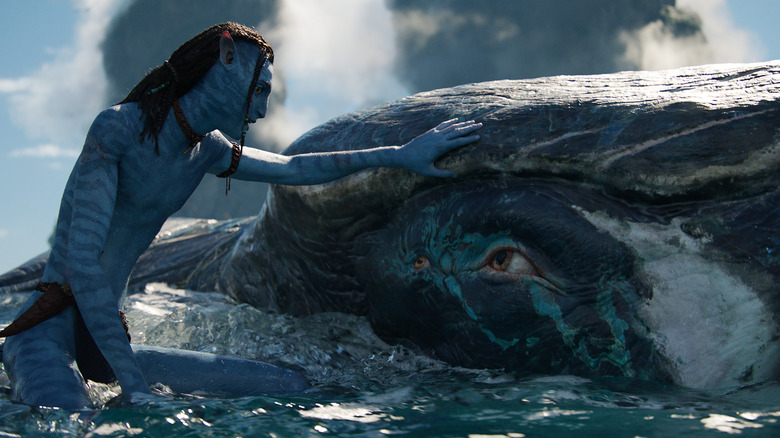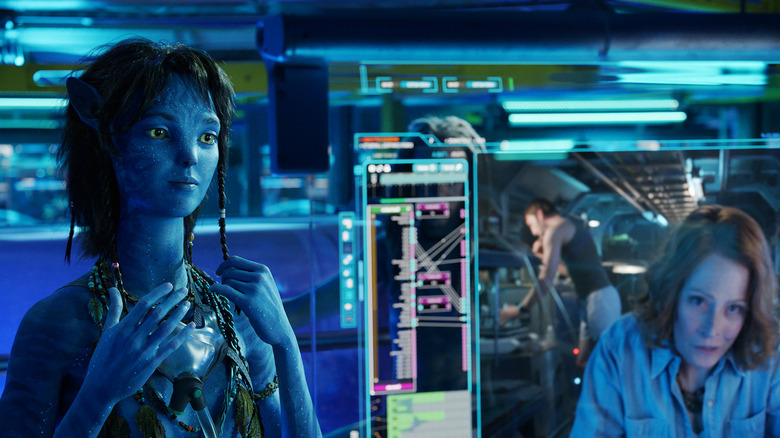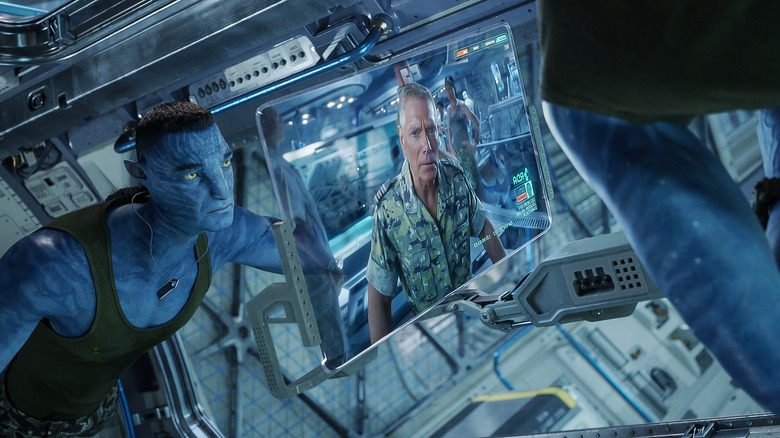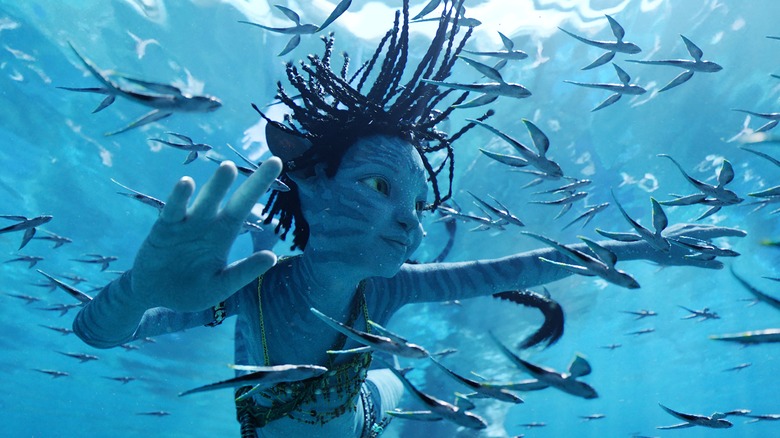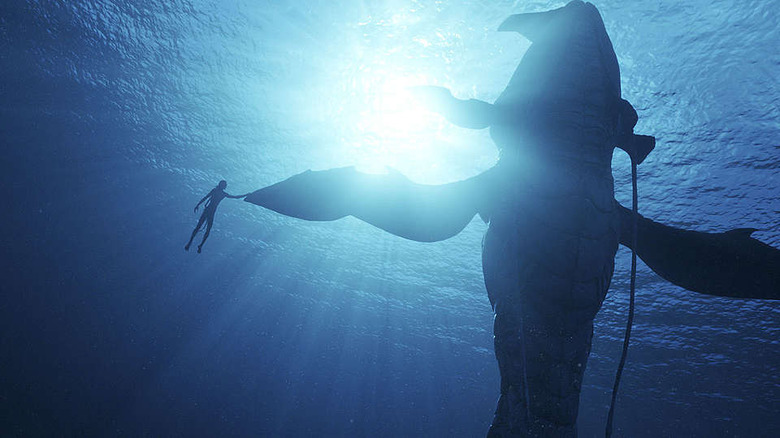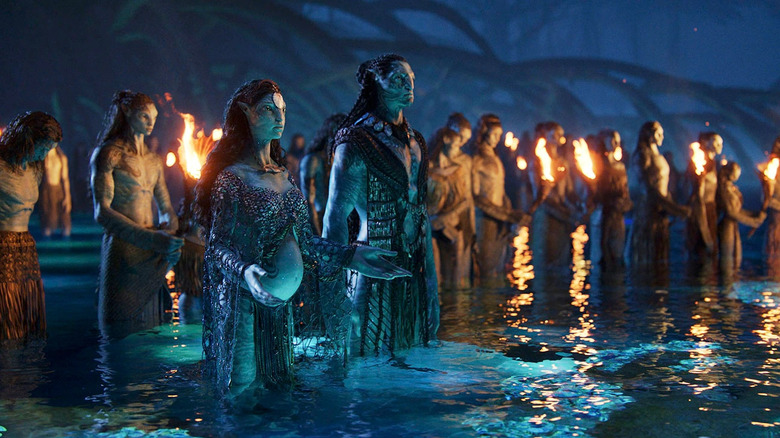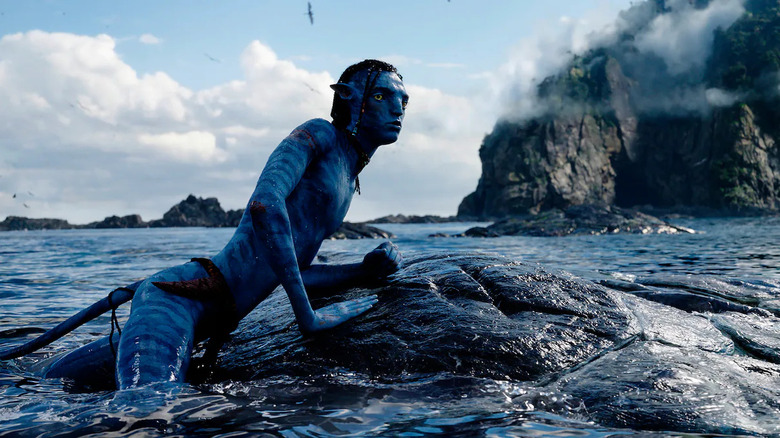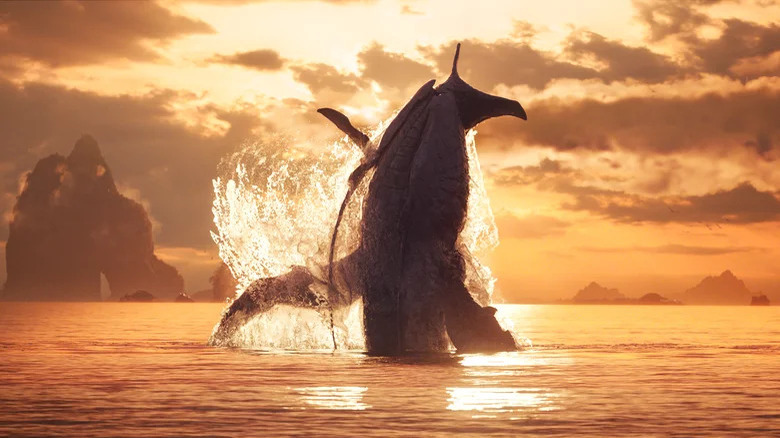After The Way Of Water, Good Luck Arguing Avatar Has No Cultural Footprint
This post contains mild spoilers for "Avatar: The Way of Water."
In the thirteen years it took for a sequel to "Avatar" to reach theaters, there's been a lot of discussion about how little cultural footprint "Avatar" has had despite its massive box office success. The common talking point is that the movie looked nice, but there wasn't anything of substance going on otherwise. The characters were functional for the plot, but rarely did they feel as complex or as memorable as, say, Jack and Rose in "Titanic."
But James Cameron has never taken much heed of Film Twitter's warnings, so he's gone all in on a string of "Avatar" sequels anyway. The new movie, "Avatar: The Way of Water," is fully expected to be a box office hit, and even if it isn't, we're still at least getting that third Avatar film, which means you'll be hearing about these movies for the next couple years whether you want to or not.
What helps is that one of Cameron's most well-documented skills as a filmmaker is that he's really, really good at sequels. He somehow made a superior sequel to "Alien" in 1986, and his 1991 film "Terminator 2: Judgment Day" is widely regarded as one of the best sequels of all time. It's a movie that reintroduced Sarah Connor (Linda Hamilton) and the Terminator (Arnold Schwarzenegger) years after the first film, both of them having changed in ways that meaningfully shook up the first film's format.
That's why despite "The Terminator" and "T2" having the same general plot, nobody ever accuses the latter of being a shameless repeat. In fact, "T2" has so firmly overshadowed the first movie in terms of its cultural impact that the original movie often feels like an afterthought. "The Way of Water" does the same thing.
From survival to protection
One of the biggest changes Cameron made with "T2" was the switch in focus from Sarah to her son John. Sarah is still there and she's still a main character, but from this point forward in the franchise, John's the one the robots want to kill. This may sound like a downgrade for Sarah, but the version of her we get in "T2" is angrier, tougher, and more complicated than the version of her we met in the original movie. Before, Sarah was just concerned about figuring out the situation and trying to stay alive; in the sequel, she's trying to both protect her son and learn to trust that the robot who once tried to kill her is now programmed to keep them safe. Hamilton's got a little less material to work with this time around, but the material she gets is some of the most compelling of her career.
Jake (Sam Worthington) and Neytiri (Zoe Saldana) go through the same basic character change in "The Way of Water." In the final battle sequence of the first film, the main source of tension was whether or not Jake and Neytiri would survive; for most of "Way of Water," all the focus is on the kids. Whether Jake or Neytiri die in that final battle almost feels irrelevant at times, because the worst-case scenario for them is not losing their lives but failing their children. Like with Sarah, this character shift might not sound great for the long-term relevance of their characters in the series — it certainly seems like the Na'vi kids are going to grow up to be the protagonists of the later films — but it makes Jake and Neytiri far more interesting than they were in the original.
A better villain
The closest thing to a T-1000 in this sequel is Quaritch (Stephen Lang), the evil colonel from the first movie who comes back as an Avatar to get revenge on Jake Sully. In the original movie, Quaritch is a one-dimensionally evil character meant to embody some of the worst traits of humanity, nothing more. It was satisfying when he died in the original, but he wasn't exactly a memorable villain. Whereas everyone can understand why, say, a villain like Agent Smith in the first Matrix film would be brought back to life for the sequels, bringing Quaritch back is a less obvious choice.
On paper, it's a boring decision, one that all but promises that "Way of Water" is only interested in treading familiar ground. Instead, as has been pointed out at /Film already, it's a decision that's led to Quaritch becoming one of the most interesting characters in the series. After all, Quaritch is now permanently stuck in the body of the alien race he originally hated, which creates this weird, complicated character arc where we see him learn to begrudgingly respect the Na'vi ways. He's got a long way to go, of course — a long, long way — but with him alone and defeated at the end, it's easy to picture a third movie where Quaritch is no longer in a strictly villainous role.
But for this second movie, Quaritch is on a singular mission to murder a specific person, and he's willing to storm through this unfamiliar world and harm all sorts of people to accomplish his goal. He's no longer just acting on behalf of a larger army; this Quaritch is his own force of nature, and that makes him a far more effective villain than he was before.
More compelling characters in general
One of Quaritch's best moments in the movie — in one of the few scenes that establish him as more complicated than just another mustache-twirling villain — is the scene where he lets go of Kiri (Sigourney Weaver) to save his own son Spider's (Jack Champion) life. He himself has been proud to say that he's not the kid's real father, and the fact that Spider's fully embraced the Na'vi culture only estranges him to Quaritch more. Despite that, there is some genuine love in this relationship, which makes Quaritch willing to briefly give up on his goals for Spider's sake.
That scene is also fascinating because of the way it deepens Neytiri's character. Threatening to murder an innocent teenager to protect her own kid is an understandable move, but a deeply cold one, something that's bound to put a strain on her relationship with Spider going forward. People have complained that Neytiri's got a lessened role in the sequel, but never has she been more interesting as a character than in that specific scene.
Basically everyone in this movie is more interesting than they were in the first one. Kiri has a more compelling character arc than what her spiritual counterpart Grace gets in the original, just as Jake has an arc that's far more nuanced than his previous straightforward white savior storyline. Even if you found "Avatar" to be a little forgettable, you'll likely be surprised by just how much you'll come to care about all these weird blue aliens by the end of this movie. Say what you will about the original, but every single member of the Sully family makes a strong, lasting impression.
A timely message
Maybe more than the characters, one of the biggest things in this sequel's favor is the themes it focuses on. The original "Avatar," as everyone is happy to point out, has a narrative very similar to "Dances with Wolves" or "Pocahontas." It's a story that's a pretty clear-cut metaphor of the real-life historical event of colonizers taking over the Americas regardless of what the natives living there had to say about it.
That central metaphor is still there in the sequel, but it's not the focus anymore. "The Way of Water" is less interested in telling a clumsy parallel to the plight of indigenous people, and is instead focused on environmental conservation as a whole. This theme was definitely there in the original movie, but it's only in the sequel that it becomes the theme, the thing that ties the whole story together. James Cameron himself hasn't been shy about this either, explaining his motivations behind the film:
"If they [the audience] just love the underwater experience — and they love that sense of the profusion of life and the magic and mystery — then maybe it will reconnect them with what we are presently losing here on this planet."
At a time when climate change is a more pressing issue than ever, a movie that's basically a celebration of the natural world is as relevant as it'll ever be, and it's handled far more gracefully here than the main theme of the original.
Aggressively, undeniably beautiful
Like the first film, "The Way of Water" is easily one of the best-looking films of its time. Not only that, but because it doesn't need to ease us into the world of Pandora like the first one, it's able to spend far more time indulging in the natural beauty of this alien world. Like the original, it's already been accused of being empty spectacle, with critics once again talking about its visuals as if they're some completely separate entity from the story's themes or writing. Unlike the original, this criticism's going to have a hard time sticking.
After all, this is a visual medium we're talking about, where the style often is the substance. This is a movie that wants you to stop and think about how beautiful the natural world is, so the level of spectacle here ties in perfectly with the conservation message. It's not just using beautiful visuals to distract you from an otherwise empty story; the visuals are the story, and it's a pretty compelling one. The movie is a love letter to nature, one that asks its audience to recapture that childlike sense of wonder they had when they were learning about their own world for the first time.
"The Way of Water" also defiantly ignores the common screenwriting wisdom that a tightly-written, fast-paced plot is vital to a good movie. At a time when every blockbuster feels like it's in a rush to get to the next plot point, "Avatar: The Way of Water" takes its time, asking its audience to simply sit back and appreciate the world for what it is. The level of patience on display here is such a breath of fresh air compared to most mainstream contemporary films.
Some undeniably memorable moments
Besides the sheer quality of the visual effects, this is a movie that simply has far more potentially memorable moments than the original movie. It's hard to forget the scene where Quaritch holds the skull of his former body in his hand and crushes it, or the scene where Lo'ak (Britain Dalton) bonds with the giant space whale Payakan for the first time.
More than anything, I don't think anyone's going to let Payakan slip from their minds any time soon. As we at /Film have pointed out already, this movie was basically the world's most expensive commercial for saving the whales, and I can think of no whale character more fitting to center that message around than Payakan. Not only is Payakan revealed to be deeply intelligent and empathetic, but he's also a total badass, getting to go on one of the absurdly cool, satisfying murder rampage ever put to screen. How many movies have you seen where a whale gets to act like a slasher villain?
Already Payakan is a fan-favorite, with even viewers with plenty of complaints about the film admitting that everything about Payakan is pretty cool. In particular, there's a scene where Payakan uses a rope to not only destroy a boat, but to literally slice off a side villain's entire arm. You can maybe complain that this is a silly scene, but you cannot say it was boring.
Putting the series in a more promising position
Perhaps the movie's biggest achievement is the way it sells viewers on the idea of multiple sequels. I think most of us were a little confused and skeptical when we first heard James Cameron had plans for four more Avatar movies. The ending of the first movie seemed pretty complete, after all; where was the story supposed to go from there?
But as the credits roll for "Avatar 2," the possibilities for "Avatar 3" suddenly seem endless. After all, a new generation of interesting characters have been introduced, and they've all got juicy potential storylines the writers can pick from. Kiri in particular, with the still-unclear circumstances around her birth, her strange connection to Eywa and her close relationship with Spider, has enough going on in her life that she could carry one of these movies just on her own.
Kiri growing up to take center-stage of the series would be almost exactly what ended up happening after "Terminator 2," after all. The difference was that while James Cameron left that franchise after the second movie (where it immediately started falling apart quality-wise), here he's going to be sticking around until at least the fourth film to see things through.
As we watch the box office numbers for "The Way of Water" roll in, it seems clear that the future for this franchise is as bright as its ever been. The Avatar movies are always going to be a little divisive, and we're always going to be hearing understandable complaints about how long they are, but like it or not, you can no longer deny they've made an impact.
